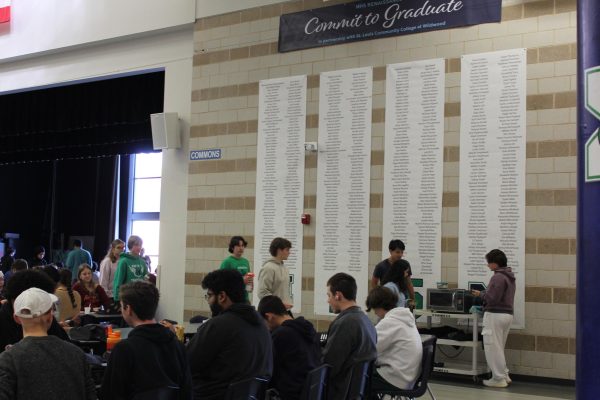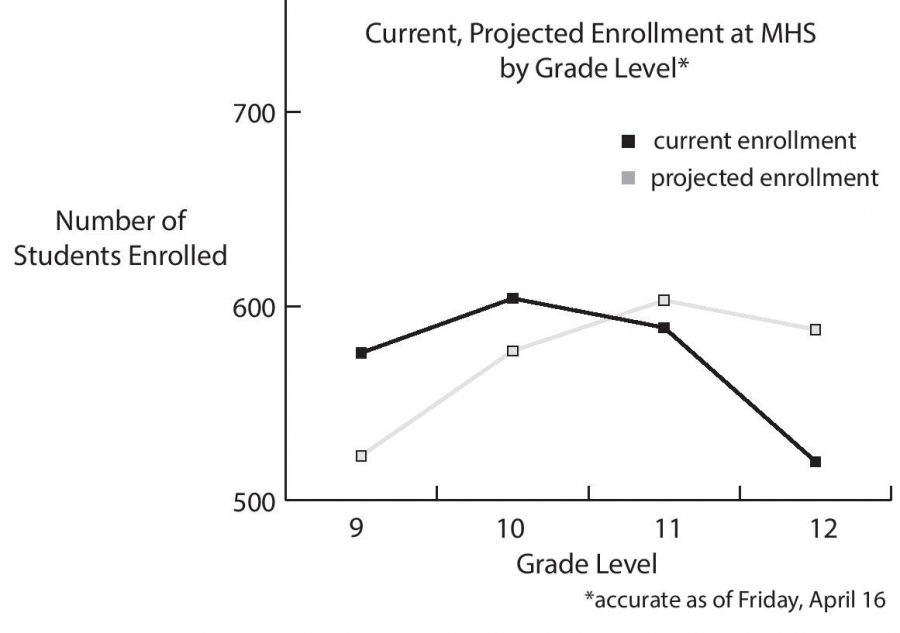Freshmen Enrollment Decreases by 9.2 Percent
Media by Waha Siddiqui
As of Friday, April 16, the current freshman enrollment is 576, sophomore enrollment is 604, junior enrollment is 589 and senior enrollment is 520, totaling 2289 overall enrollment, according to the MHS Registrar. There are 523 freshmen, 577 sophomores, 603 juniors and 588 seniors enrolled at MHS for the upcoming fall semester. While the distribution of classes has shifted, the overall enrollment is around the same number.
When RSD announced it was starting off the 2020-2021 school year virtually, Brady VanGerpen, eighth grader, made the switch from public to private school.
VanGerpen, who originally went to Selvidge Middle School, now attends Whitfield School after COVID-19 allowed for a period when the transition to a smaller private school was best for his family. In addition, virtual learning wasn’t the best way to learn, VanGerpen said.
“We were always looking for another school other than Marquette because tons of people go there and it can get crowded,” VanGerpen said.
Now, VanGerpen said Whitfield’s protective measures and mask mandates are similar to those at MHS, but he doesn’t see himself returning anytime soon.
VanGerpen is not alone in his decision to opt-out of schooling at MHS. As of Friday, April 16, the incoming freshmen enrollment is down by approximately 9.2 percent from last year, according to Anna Speaker, MHS Registrar.
While the percentage stands out, Speaker said it’s not completely out of the ordinary. The overall school enrollment has not changed drastically. The shift lies in the distribution of the classes.
“It could be that more kids are going to private schools, or it could just be a smaller class,” Speaker said. “If you have fluctuations going around all across the district that feeder pattern can magnify.”
Enrollments will continue to come in through the summer, and Speaker said they will probably even out. However, over the past few years, the overall enrollment has been going down too.
Speaker said overall enrollment was pushing 2400 last school year, but it is now at 2289. Next year, it is projected to be at 2291 students.
If the trend of low numbers of enrollment continues, Speaker said it could affect staffing at MHS. “Points” are received based on enrollment numbers, which are used to employ teachers, administration and supporting staff.
There is a 90 student difference between the overall enrollment between August of 2019 and the projected August enrollment of 2021, which Speaker said is about three classrooms worth of students. It is unlikely teachers will lose three hours of classes, but that is 90 students who aren’t requesting certain courses, which may already have a small enrollment.
“If the trend continues, you might see fewer types of classes offered, or higher class sizes, because there aren’t enough students requesting or enough points to hire a teacher to teach another hour of that class,” Speaker said.
While classes have shrunk, Principal Dr. Steve Hankins doesn’t see a trend yet. About 15 years ago, Dr. Hankins sat in on a bond committee meeting that was projecting the demographic shifts of the future classes.
“Based on homes being built in the area and families moving in, we knew that a bubble was coming about the time it came,” Dr. Hankins said.
That is what Dr. Hankins attributes the increased sizes in past classes. It isn’t a downward trend in enrollment, rather just a few very large classes based on demographic estimates.
Although the school can’t pinpoint why families might move out of the district, Dr. Hankins said it might have to do with the loss of jobs in the area and moving based on employment in the past year, which is a trend isolated from the COVID-19 pandemic.
Changes in staffing don’t always equate to loss of students, as it may have to do with a change in student interests. If more students are showing an interest in a specific subject than usual, then the school might hire within the building (in-house) or look outside the building.
“For staffing, you can’t look year to year,” Dr. Hankins said. “You have to look two to three years ahead to plan for that. Their jobs are important. We want to make sure they can keep their jobs.”
Your donation will support the student journalists of Marquette High School. Your contribution will allow us to purchase equipment and cover our annual website hosting costs. You may become a PATRON by making a donation at one of these levels: White/$30, Green/$50, Blue/$100. Patron names will be published in the print newsmagazine, on the website and once per quarter on our social media accounts.

Waha Siddiqui, senior, is the Editor in Chief of the Messenger for the 2020-2021 school year. Beside her involvement in student journalism at Marquette,...







